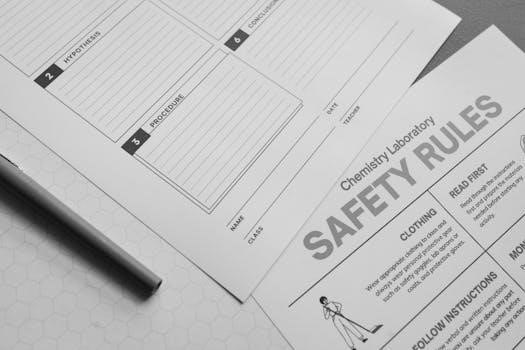ShelterLogic 10×20 Instructions⁚ Assembly and Setup
This guide provides a comprehensive overview of assembling and setting up your ShelterLogic 10×20 shelter. It covers crucial aspects, including preparation, frame assembly, cover installation, anchoring, safety precautions, and maintenance tips. By following these instructions carefully, you can ensure a successful and safe setup.
Initial Steps and Preparation
Before beginning the assembly of your ShelterLogic 10×20 shelter, thorough preparation is crucial for a smooth and efficient process. First, carefully unpack all components and verify against the parts list in the manual to ensure everything is present. Familiarize yourself with each part to streamline assembly.
Next, select a suitable location for your shelter. The area should be level, clear of obstructions like trees or overhead power lines, and large enough to accommodate the shelter’s dimensions, allowing space for movement during setup. Consider potential weather conditions and ensure proper drainage to prevent water accumulation.
Gather the necessary tools, such as wrenches, sockets, and a rubber mallet, as specified in the manual. Having these tools readily available will save time and prevent frustration during assembly. It’s also advisable to have at least two people for the assembly process, especially during frame construction and cover installation, to ensure safety and stability.
Finally, read the entire instruction manual completely before starting. This will help you understand the assembly sequence, identify potential challenges, and familiarize yourself with safety precautions.
Identifying Parts and Components
Prior to commencing the ShelterLogic 10×20 assembly, accurately identifying each part and component is essential. Begin by laying out all the pieces on a clean, flat surface. Consult the parts list provided in your assembly manual; it typically includes detailed diagrams and descriptions of each item.
Pay close attention to the different types of poles, connectors, and footings. The poles might be swedged (tapered) on one end to allow for easy slip-fit connections. Connectors will vary in shape and size, designed to join the poles at specific angles and locations within the frame. Footings provide a stable base and may include pre-drilled holes for anchoring.
The cover is a critical component. Examine it for any markings indicating the front, back, or side orientations. Note any zippers, attachment points for the frame, and the valance, which is the decorative fabric trim along the edges.
Finally, separate and organize the hardware, such as bolts, nuts, screws, and bungee cords. Keeping them organized will significantly speed up the assembly process and reduce the risk of using the wrong hardware for a particular step.
Frame Assembly⁚ Step-by-Step Guide
The frame assembly is the backbone of your ShelterLogic 10×20 shelter. Begin by connecting the footings to the vertical poles. Ensure they are securely attached as these will bear the entire structure’s weight. Next, assemble the roof frame. Typically, this involves connecting multiple poles with specific connectors to form the roof’s shape.
Refer closely to the assembly manual for the correct order and orientation of these connections. Once the roof frame is assembled, carefully lift it and attach it to the vertical support poles. Secure all connections with the provided hardware, ensuring a snug fit, but avoid over-tightening initially.
Repeat the process for the remaining sides of the frame. As you proceed, periodically check that the frame is square and level. This is crucial for the overall stability and appearance of the shelter.
Once the entire frame is erected, double-check all connections and tighten the hardware fully. The frame should now be sturdy and capable of supporting the cover. Ensure all poles are correctly aligned and firmly seated in their respective connectors before moving on to the next step.

Cover Installation and Securing

Carefully unfold the cover, ensuring it is free from any creases or folds. Position the cover over the assembled frame, aligning it according to the manufacturer’s instructions. The cover usually has specific markings or labels to help with proper orientation. Begin securing the cover at the corners, using the provided bungee cords or fasteners.
Stretch the cover evenly as you attach it to the frame, working your way from the corners towards the center. This will help prevent wrinkles and ensure a snug fit. Pay close attention to areas around the legs and any designated attachment points. Make sure the cover is pulled taut, but avoid over-stretching it, as this could cause damage.
Once the cover is fully attached, inspect it for any loose areas or gaps. Readjust the bungee cords or fasteners as needed to achieve a uniform and secure fit. Proper cover installation is essential for weather protection and the overall stability of the shelter.
Finally, ensure that all attachment points are securely fastened and that the cover is properly aligned with the frame. A well-installed cover will not only protect your belongings but also extend the lifespan of the shelter.
Anchoring the Shelter
Properly anchoring your ShelterLogic 10×20 is crucial for its stability and safety, especially in windy conditions. Begin by identifying the appropriate anchoring method based on the surface you’re installing the shelter on, such as soil, concrete, or asphalt. For soil, use ground stakes or auger anchors, driving them deep into the ground at each leg of the shelter.
Ensure the stakes are angled outwards for maximum holding power. For concrete or asphalt, use concrete anchors or weight bags filled with sand or gravel. Securely attach the anchors to the frame using ropes, straps, or the hardware provided with your anchoring kit. Make sure the connections are tight and reliable.
Regularly inspect the anchors and tighten them as needed, especially after heavy rain or strong winds. Consider using additional anchoring measures, such as guy lines, for added stability in high-wind areas. Remember, a well-anchored shelter is less likely to be damaged or blown away, protecting your belongings and preventing potential hazards.
Always consult the manufacturer’s instructions for specific anchoring recommendations and follow local building codes and regulations. Neglecting to properly anchor your shelter can result in serious damage or injury.
Recommended Tools
Having the right tools on hand will significantly ease the assembly process of your ShelterLogic 10×20 shelter and ensure a secure and efficient setup. A rubber mallet is essential for gently tapping frame components together without causing damage. A socket set or adjustable wrench will be needed to tighten bolts and nuts securely, ensuring the frame is stable and robust.
A measuring tape is crucial for accurate placement and alignment of the shelter and its components. Work gloves will protect your hands from sharp edges and provide a better grip while handling the frame parts. A step ladder or sturdy platform can be helpful for reaching higher sections of the frame during assembly and cover installation.

A utility knife or scissors will be necessary for opening packaging and trimming any excess material. Depending on your chosen anchoring method, you may need a hammer drill for concrete surfaces or a post driver for ground stakes. Consider having a level on hand to ensure the shelter is evenly positioned and stable.
Finally, a helper is highly recommended, as assembling a shelter of this size is much easier and safer with two people.
Safety Precautions During Assembly
Prioritizing safety during the assembly of your ShelterLogic 10×20 shelter is crucial to prevent injuries and ensure a smooth process. Always wear work gloves to protect your hands from potential cuts or scrapes from the metal frame components. Eye protection, such as safety glasses, is also recommended to shield your eyes from debris or accidental impacts.
Ensure that the assembly area is clear of any obstacles, including children and pets, to prevent tripping hazards or distractions. When lifting or moving heavy frame parts, use proper lifting techniques, bending your knees and keeping your back straight, or enlist the help of another person to avoid strain or injury.
Be aware of overhead power lines and maintain a safe distance to prevent electrical hazards. Never assemble the shelter during high winds or inclement weather, as this can make the process unstable and dangerous. Securely anchor the shelter as soon as possible after assembly to prevent it from being blown over by gusts of wind.
Carefully read and understand all instructions before beginning assembly, and follow them precisely. If you are unsure about any step, consult the manual or contact ShelterLogic customer support for assistance.
Maintenance and Care Tips
To ensure the longevity and optimal performance of your ShelterLogic 10×20 shelter, regular maintenance and care are essential. Periodically inspect the frame for any signs of rust or damage, and promptly repair or replace any compromised components. Apply a rust-resistant coating to the frame to protect it from the elements and prevent corrosion.
Keep the cover clean by regularly washing it with mild soap and water. Remove any dirt, debris, or mildew that may accumulate on the surface. Ensure the cover is completely dry before storing it to prevent mold growth.
Check the tightness of all connections and fasteners periodically, and tighten them as needed. Inspect the anchors regularly to ensure they are securely holding the shelter in place. In areas with heavy snow or strong winds, consider using additional anchors or support structures for added stability.
During periods of heavy snowfall, remove excess snow from the cover to prevent it from collapsing under the weight. Store the shelter in a dry, protected location during the off-season to prolong its lifespan. Following these maintenance and care tips will help you keep your ShelterLogic 10×20 shelter in top condition for years to come.
Troubleshooting Common Issues
Even with careful assembly and maintenance, you might encounter some common issues with your ShelterLogic 10×20 shelter. One frequent problem is a sagging cover. This can be caused by improper tensioning during installation or stretching of the fabric over time. To resolve this, try tightening the cover using the bungee fasteners or ratchet straps. If the cover is excessively stretched, consider replacing it.
Another common issue is frame instability, often due to loose connections or inadequate anchoring. Inspect all connections and tighten any loose bolts or screws. Ensure that the anchors are securely fastened to the ground and are appropriate for your soil type. If necessary, add additional anchors or use heavier-duty anchors for increased stability.

Tears or rips in the cover can occur due to sharp objects, excessive wind, or prolonged exposure to the sun. Repair small tears with patching tape designed for outdoor fabrics. For larger tears, consider replacing the entire cover. Condensation buildup inside the shelter is another potential issue, especially in humid environments. Improve ventilation by opening the shelter’s doors or windows, or consider using a dehumidifier to reduce moisture levels.
Temporary vs. Permanent Structure Considerations
The ShelterLogic 10×20 is primarily designed as a temporary shelter solution, offering flexibility and portability. Unlike permanent structures, it doesn’t require extensive foundation work or permits in many areas. This makes it ideal for seasonal use, such as providing shade during summer events or protecting vehicles during the winter months. However, its temporary nature also means it’s not built to withstand extreme weather conditions or long-term exposure like a permanent building.
When deciding whether to use the ShelterLogic 10×20 as a temporary or semi-permanent structure, consider the local climate and potential weather hazards. In areas with heavy snowfall or strong winds, it’s crucial to reinforce the shelter with additional anchoring and possibly a stronger frame. Regularly inspect the structure for any signs of wear or damage, and take prompt action to address any issues.
For long-term storage or use in harsh environments, a permanent structure may be a more suitable option. Permanent structures offer greater durability, weather resistance, and security. They also provide the possibility of adding insulation, electricity, and other amenities. Carefully weigh the pros and cons of each option before making a decision, taking into account your specific needs and budget.
